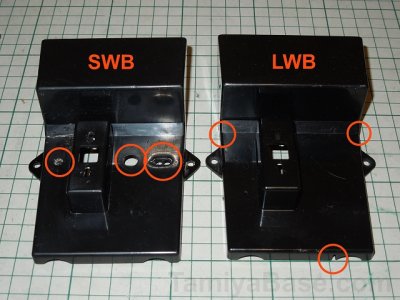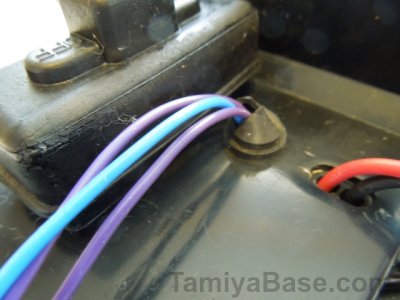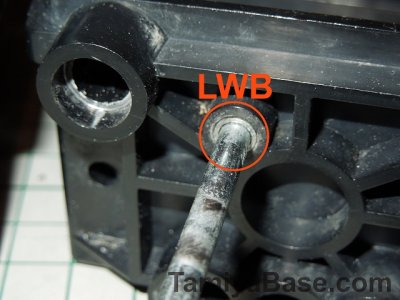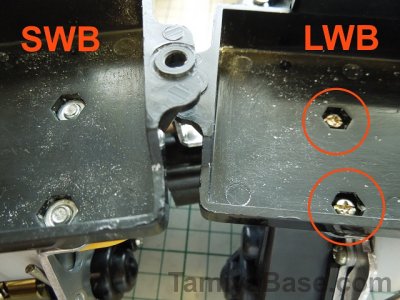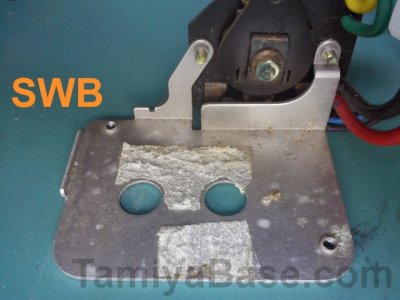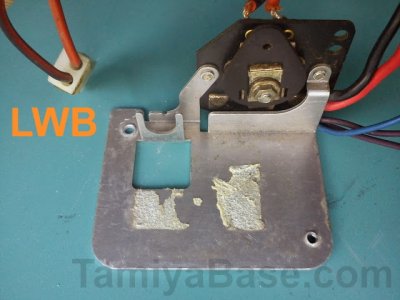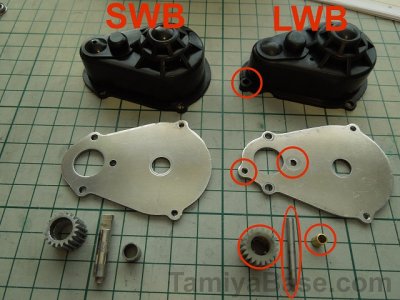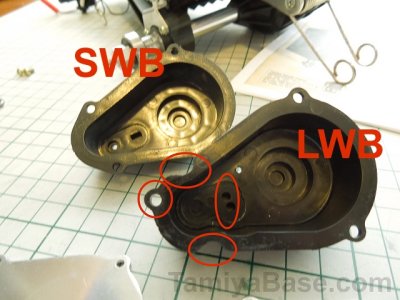It's been a while since I penned part one (detailing the differences between the Wild Willy M38 and Wild Willy 2 body and fittings), this time I'll be covering the differences in chassis parts on the earlier "Short" wheelbase (SWB) and the later "Long" wheelbase (LWB) versions.
"Short" and "Long" are actually something of a misnomer as the actual difference in wheelbase (the distance between wheel centres front to back) is only something like 10mm.
Wild Willy 2 vs Wild Willy M38s
Let's start with the most obvious difference between the two: on what Tamiya call the "Arm Stay". The SWB version has a round hole, and the LWB parts are longer overall with a slot.
As a footnote, a prototype version of the Wild Willy, which can be seen in an "action" pic on the Body Set box and in a least one Tamiya Catalogue, didn't have any sort of perforation.
Also needing a mention here is part J5 (on the inboard end of the servo saver shaft) has a raised pip, I would guess to try to reduce friction. In reality all it did was wear a pronounced ridge in the inside of the chassis tub.
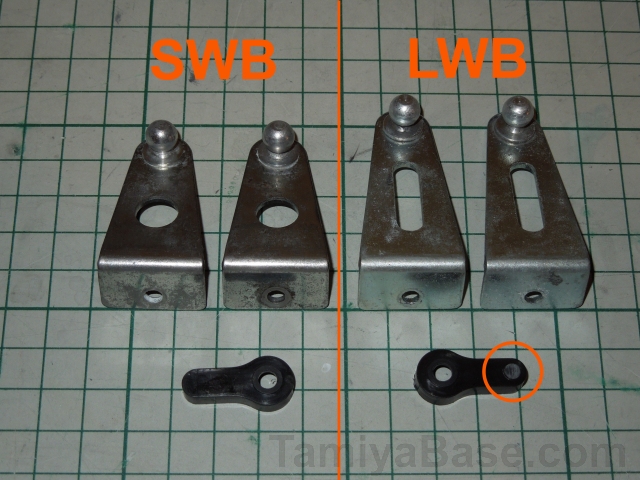
Next up, the "Mechanism Box Lid". The SWB has holes on the top for (from left to right) the antenna wire, speed control resistor wiring, and battery cables.
The LWB on the other hand has slots (that match corresponding ones in the chassis tub) for those wires, in theory making it easier when you have to remove the lid.
BTW, the rubber plug for the SWB resistor wiring is a 3-speed gearbox bung, now easily available with the Bruiser and Mountaineer re-releases.
Moving on to the chassis tub, there are a few detail changes:

- LWB tub has slots for the antenna wire, resistor & battery leads (these correspond to slots in the Mechanism Box Lid);
- Holes for the "Switch Stay" (mechanical speed control, or MSC) become slots on the LWB tub;
- the hole in the front of the tub for the steering ("Servo Saver Shaft") is larger on the LWB tub, with a simple metal sleeve acting as a bearing;
- Where the upper gearbox brackets ("Motor Base A" and "B") fix on to the tub, the SWB Willy has M4 screws fitted from underneath into M4 nuts, so there are 4mm holes in both the tub and the "Base" brackets. On the LWB version, M3 screws are fitted from the top, through 3mm holes in the tub into M3 threaded holes in the "Motor Base"s .
The "Switch Stay" also sees some changes between versions: the LWB pressing is narrower & loses the reinforcing fold, but gains an upright section which helps to position the MSC servo.
(Thanks to waterbok for these two pics).
The long rear arms - for the LWB version an ornamental hole is deleted, and the stabiliser bar mount points move forward.
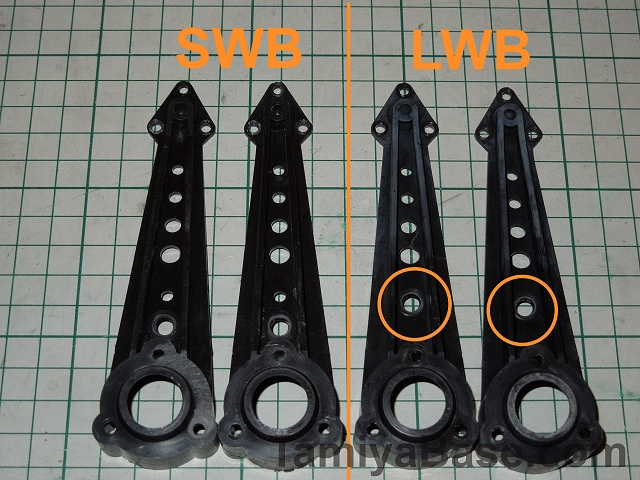
Front suspension strut tops & pipe clamps: the SWB has 2mm clearance holes + M2 screws fitted from underneath into the plastic tops. On the LWB the screws are fitted through the tops in M2 pressings in the clamps.
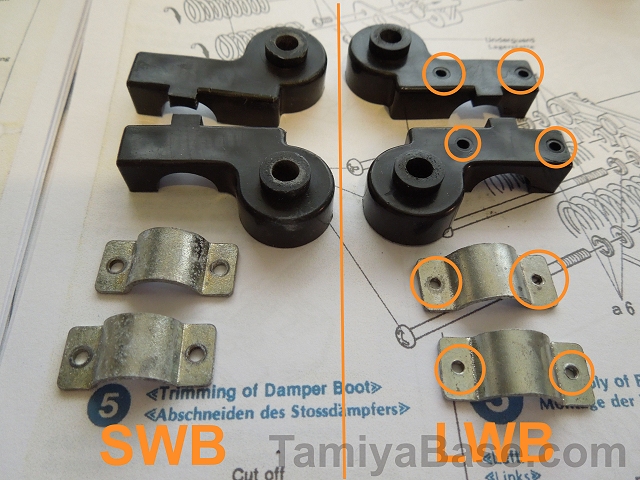
Rear spring "Lower Seat" : machined from Aluminium on the SWB, pressed steel on the LWB.
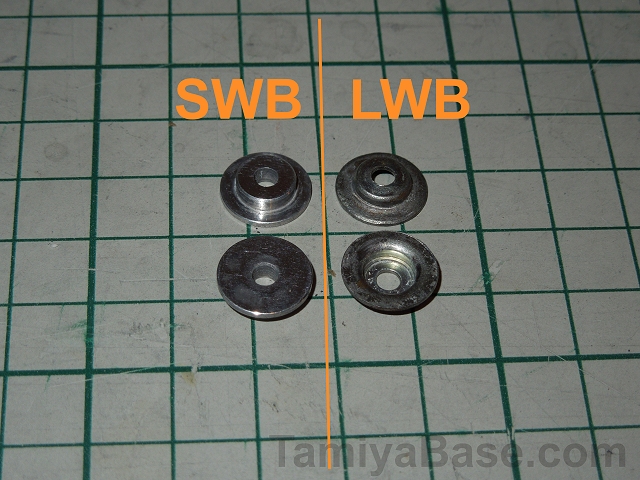
Rear Spring Stays have a larger hole on the LWB and the brass fitting has a corresponding extra step.
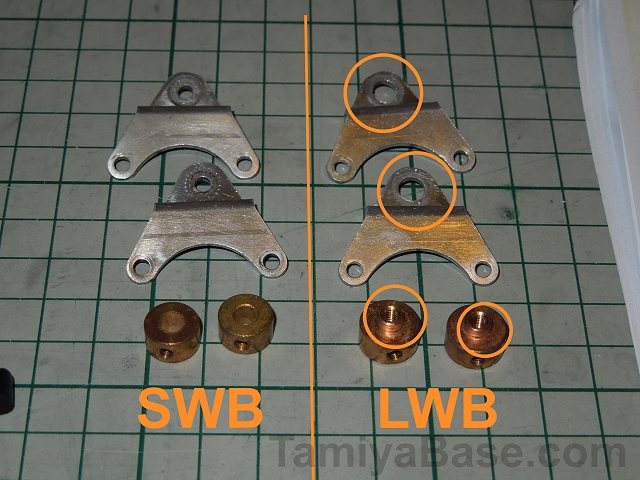
"Rear Catch" (body post) parts: LWB has shorter spring & a stepped base.
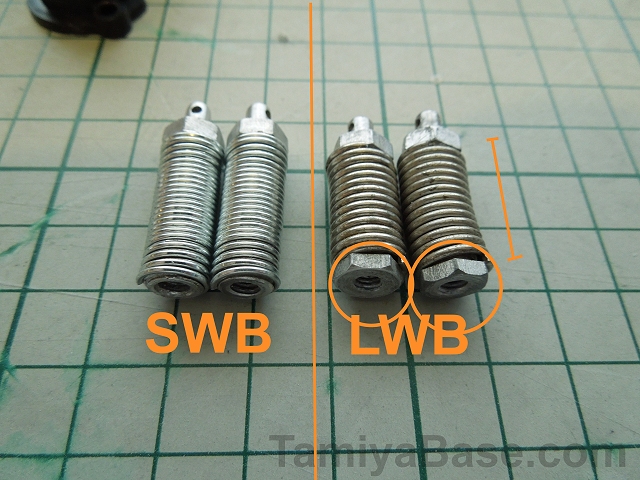
Wheelie bars: LWB parts have a more acute angle.
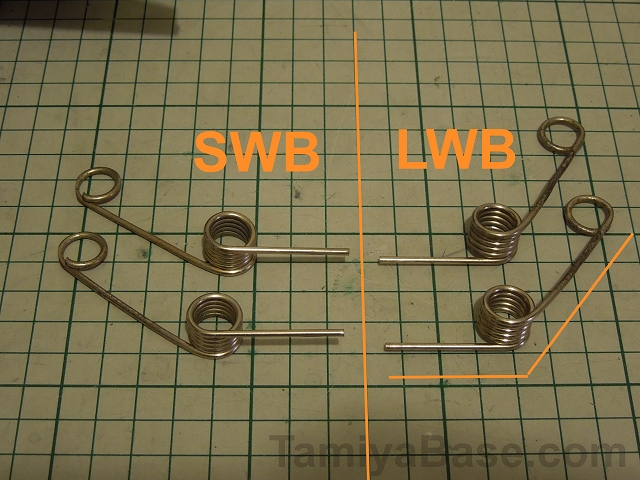
This is a subtle difference, but if you look at the bumper mounting points on the LWB bulkhead you'll see the holes are much deeper.
(Thanks again to waterbok for the photo).
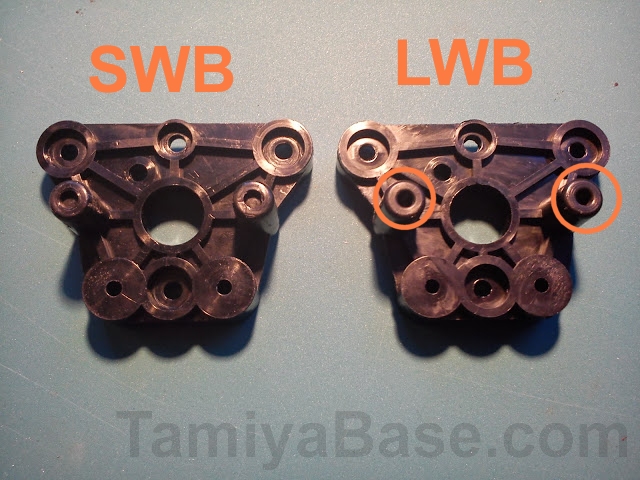
Moving to the back of the chassis again, we've already covered the 4mm clearance holes on the SWB vs the M3 tapped holes on the LWB "Motor Base"s - but the overall length is different, as are the shapes of the motor mount & wire holes.
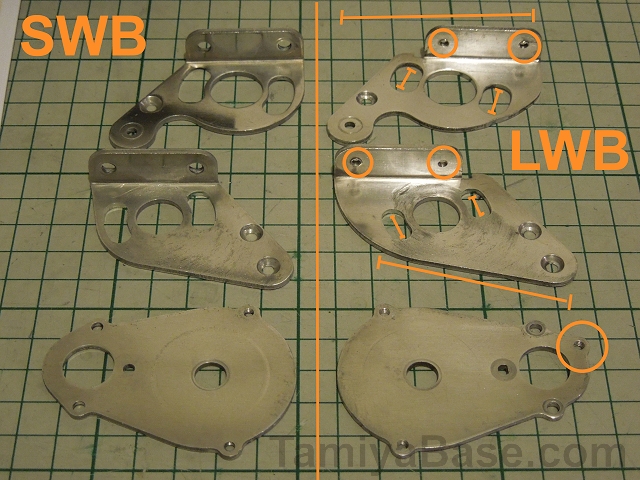
The "Differential Gear Case" of the LWB Willy has a small aluminium skid plate. The plastic mouldings have rebates to suit.
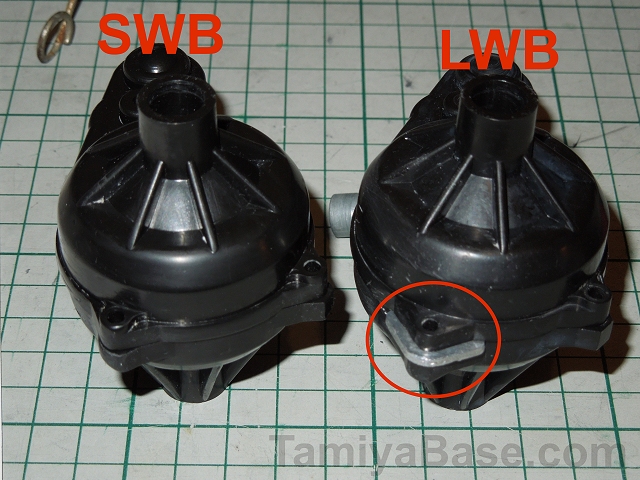
The upper "Gearbox" also has differences. For a start, the idler gear is alloy on the SWB (and runs on a 5mm shaft and two flanged bearings - MF85 if you want to replace them), but on the LWB it's nylon and runs on a 3mm shaft (and 730 bearings). The aluminium backplate and the black plastic cover are different to suit.
Furthermore, the backplate and cover also have a slightly different clamping screw arrangement.
Finally, body clips: on the SWB these should be the type with the "waggly" bit on the inside (compared to the large loop)- the LWB and most other cars have the "normal" arrangement with it on the outside.
(Photo: waterbok)
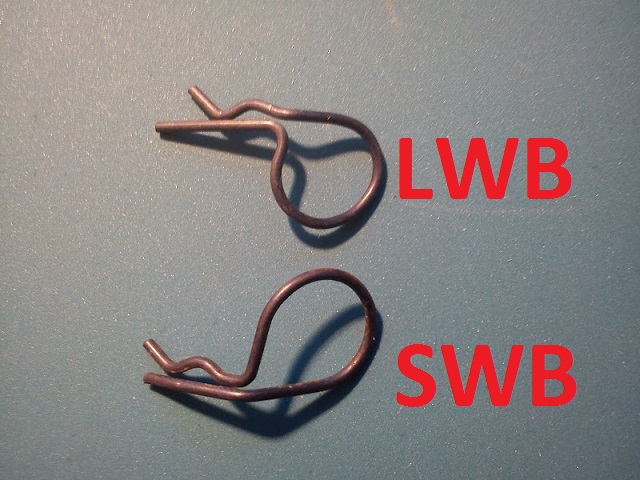
The manuals deserve a mention too - the manual for the LWB chassis not only shows the revised parts but many of the illustrations have been done from different angles, and in places the assembly order changes. Having built both I don't think either one is easier than the other, the front end especially is fiddly in either incarnation & overall one set of difficulties replaces another.
Willy's Wheeler
The chassis is basically the same as the M38 LWB, but has some obvious differences: the front bumper (often missing) & bracket, splitter & bracket, rollbar, single wheelie bar/spring, wheels & tyres.
The motor pinion is larger to account for the smaller wheels, and the back plate of the primary gearbox has the idler gear shaft hole offset to accommodate it. It's also stamped "RCC Quattro", so it's rather obvious what came first in Tamiya's design thinking.
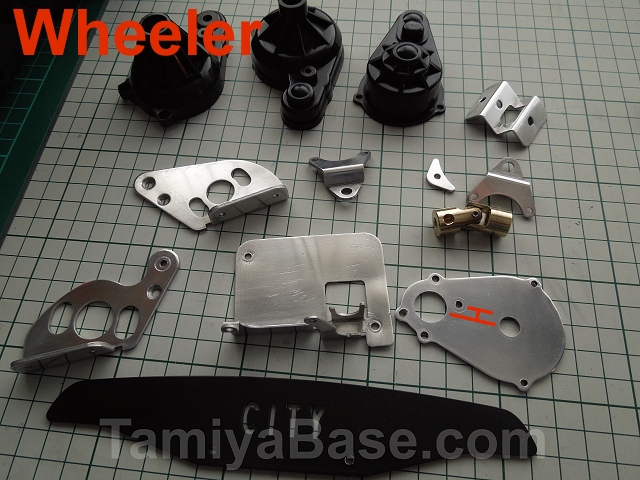
M38 SWB & LWB vs Wild Willy
With the exception of a few screw and bearing dimensions, the chassis of the "M38" and "2" generations of the Wild Willy have no parts in common.
Opel Ascona & Audi Quattro
I don't own either of these so no photographs, but fundamentally the chassis are the same as the Willy's Wheeler but with different tyres, and an extended chassis tub and mechanism box lid. Neither have a wheelie bar.
________________________
Written by TB member Jonny Retro




